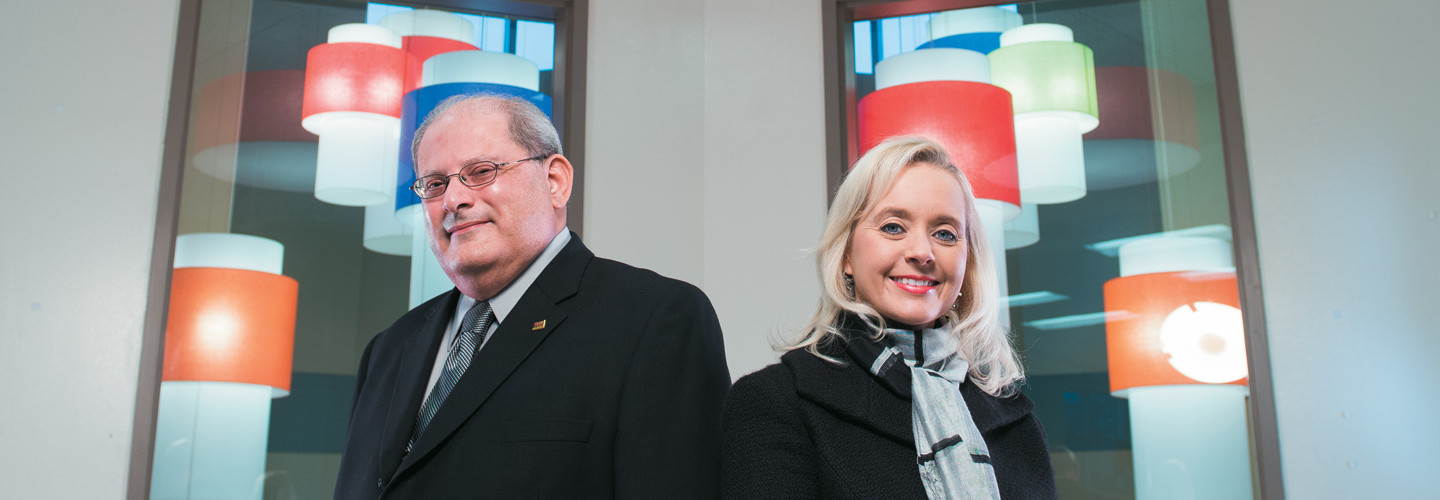Tracking Shawnee Mission School District’s Technology Overhaul
Prologue
Incorporated in 1969, when 13 school districts unified into one, the Shawnee Mission School District is the third largest district in Kansas. Today, it serves roughly 27,450 students at 33 elementary schools, five middle schools and five high schools in the Kansas City area.
By January 2012, it became clear to district stakeholders that the time had come to invest in SMSD's future and upgrade its aging technology infrastructure.
Winter – Spring 2012: Forming the Plan
A committee of key decision-makers met over several months to offer and evaluate suggestions for a range of capital improvements, says Associate Superintendent for Communications Leigh Anne Neal. Better support for classroom technology, a more robust network and a new telephone system (to replace the nearly 20-year-old system in place at the time) were near the top of the committee's list of recommendations.
"The committee believed strongly that the curricular program must inform the planning for classroom technology," Neal explains. "A survey of the community and staff identified technology as an essential need." Not long after the recommendations were made, the local school board approved capital outlay funding for a wireless network upgrade and a new Voice over IP phone system with unified communications features.
Summer 2012 – Winter 2013: Making Choices
According to Neal, a district selection committee spent the better part of the summer and fall reviewing offerings from several wireless and telephony equipment manufacturers. Multiple meetings were held to understand the advantages and disadvantages of each system and how it would best serve the district.
By late winter, the committee had narrowed its list to Aruba Networks for wireless and Cisco Systems for telephony and unified communications. After identifying which solutions to deploy in early 2013, SMSD leaders selected CDW•G to implement them. CDW•G's strong partner relationships with Aruba and Cisco, as well as its engineering and deployment experience with both sets of technologies, were important factors in the decision.
"By selecting a single vendor to install the phone and wireless systems at the same time, we were able to complete the work in a shorter time frame using the same field personnel, resulting in both efficiencies and cost savings," Neal says, adding that having CDW•G conduct one infrastructure assessment for both projects during its initial phase also saved time and money.
According to Kourtney Dierking, CDW•G's K–12 field account executive on the project, district officials chose Aruba because its wireless equipment supported video traffic and multimedia more effectively. They selected Cisco for UC and telephony because they wanted updated systems with unified communications features, she adds.
"They wanted modern telephony, the ability to collaborate by running video conferences and WebEx sessions, and instant messaging and presence via Jabber," Dierking says.
72 The total landmass, in square miles, of the Shawnee Mission School District — a distance that encompasses 53 buildings
Even fairly simple features, such as "Find Me, Follow Me" within Cisco's UC solution, make a big difference to the staff, Neal says. "Now, I can have my desk phone number follow me wherever I go and pick up in the field on my cellphone," she explains. "It's just a much better way for us to work and remain connected when we are out at various schools during the day."
Cisco Unified Communications technology also integrates well with the district's Microsoft Exchange email software and back-end Cisco switches, adds Bill Sandburg, SMSD's supervisor of wide area networks and telecommunications. Another important UC feature is the Cisco Emergency Responder application, which lets the district receive notification of any 911 calls (including the district location from which a call originates) in real time.
On the Wi-Fi front, Sandburg says the SMSD IT department appreciated the more granular diagnostics available in the AirWave Network Management tool Aruba offers.
"Most management tools will let you look at a client's present activity. But AirWave lets us look at the past activity of all the clients so we can get a better sense of what's been happening on the network," he explains.
Aruba's ClearPass Access Management System also enabled IT to easily set up a guest network for BYOD devices, Sandburg adds.
Late Winter – Summer 2013: Laying the Groundwork
Once the contract was signed last January, district officials worked closely with CDW•G's project management team to plan the full scope of the project. As planning progressed, CDW•G performed a network readiness assessment in each of the district's 53 buildings to determine any additional network switching needs and other network requirements to ensure optimal telephony and wireless performance.
"By putting an access point in every classroom, the district went above and beyond the norm, but they wanted to have that density of coverage to give teachers and students a richer experience," says Dan Morris, a senior project manager for CDW•G. "Another one of our big challenges was simply the time frame, because we had to have the network up and running by the time the new school year started in August."
By March, SMSD's IT team and CDW•G installers were conducting walk-throughs in all district buildings to determine phone and access point placement. Final design work on the wireless network and phone system began later that month, and final review of all site surveys was completed in April. Phone system programming began shortly after that, and the first installation and cutovers began in May and continued through the summer. New phones with the UC features were placed in each classroom, along with an AP, Neal says.
Fall 2013: Going Live
By the time the new academic year commenced on Aug. 12, 2013, installation was complete in all but three middle schools that were being remodeled. Work at those schools was done by the end of the second week of classes.
In the near future, the district will expand WebEx to connect instructional resource specialists through video conferencing and will offer professional development sessions as well.
Teachers and staff are quite taken with the new phone systems — particularly the unified communications features. And the improved wireless capacity and unified communications have already had a dramatic impact in the classroom, especially as teachers and students work on school projects that incorporate tablets.
"Having more concurrent wireless connections in our classrooms offers teachers and students a faster option for accessing digital media and for collaborating on projects digitally in the future," Neal says.
Technology Makes It Happen
A massive undertaking, the technology overhaul at the Shawnee Mission School District in Johnson County, Kan., was conceived and deployed in a matter of months. The following pieces brought the new system to life:
Wireless
2,323 — Aruba AP-134 and AP-135 wireless access points
7 — Aruba 7210 mobility controllers
ClearPass Access Management System
AirWave Network Management
UC Servers
2 — Cisco UCS C240 M3 rack-mount servers
Cisco UCS C220 M3 rack-mount server
Phones
3,191 — Cisco Unified IP Phone 6945
171 — Cisco Unified IP Phone 8945
8 — Cisco Unified IP Phone 9951
Back-End Network Switches
187 — Cisco Catalyst 2960-S








